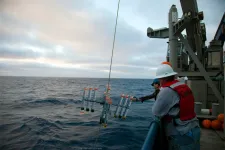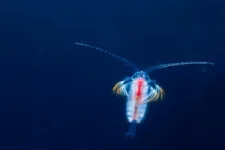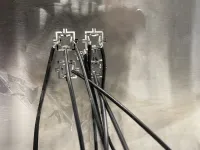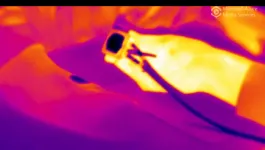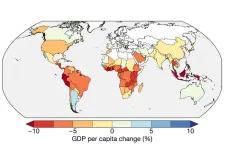(Press-News.org) Florida State University researchers have analyzed the carbon exported from surface waters of the California Current Ecosystem — the first-ever study to quantify the total carbon sequestration for a region of the ocean.
The study, published in Nature Communications, serves as a framework for assessing how the processes that sequester carbon might change in a warmer world, while also creating a blueprint for similar budgets in other ocean regions.
Understanding the carbon cycle — the sources and reservoirs of carbon — is an important focus of Earth sciences. Many studies have examined the carbon sequestered by sinking particles formed from algal production. Fewer studies have focused on plankton particles that move to the deep ocean through other methods or the marine life that migrates vertically through layers of the ocean.
“Our study is the first to put all of these different processes together to fully investigate the processes driving the biological carbon pump for a major ocean region,” said lead author Michael Stukel, an associate professor in FSU’s Department of Earth, Ocean and Atmospheric Science.
Stukel and his team found that a host of processes contribute to the movement of organic carbon through the marine ecosystem. Their analysis confirmed that sinking particles are the dominant process transporting carbon, but they also found that particles transported by ocean currents and zooplankton that migrate down into the deep ocean every day contribute 30 to 40 percent of carbon sequestered in the deep ocean.
The data comes from 15 years of research cruises by the California Current Ecosystem Long-Term Ecological Research program in an area that spans from San Diego to Monterey Bay and extends about 300 miles offshore. Stukel and his team combined information collected during those trips with computer modeling.
The algae in the surface ocean perform about half the world’s photosynthesis, but they live for a week, so the carbon dioxide they take in only gets sequestered if the carbon created by plankton somehow moves into the deep ocean, a process known as the biological carbon pump.
That process transports five to twelve petagrams of carbon into the deep ocean every year. For perspective, humans emit about ten petagrams of carbon annually.
As climate change alters the Earth, it’s unclear how it might affect processes like the biological carbon pump.
“We don’t know if the biological carbon pump will take up more or less carbon dioxide in the future,” Stukel said. “The first step in answering that question is putting together a full budget for what’s happening now. We think our study is an important step in the process of fully understanding how the biological carbon pump works today and hence, how it will change in the future.”
This research was supported by the National Science Foundation.
Co-authors were John P. Irving, Christian K. Fender and Natalia Yingling, all from Florida State University; Thomas B. Kelly, an FSU doctoral graduate who is now a postdoctoral researcher at the University of Alaska Fairbanks; and Mark D. Ohman from the University of California San Diego.
END
FSU researchers analyze carbon sequestration in California Current Ecosystem
2023-05-18
ELSE PRESS RELEASES FROM THIS DATE:
Smart material prototype challenges Newton’s laws of motion
2023-05-18
COLUMBIA, Mo. – For more than 10 years, Guoliang Huang, the Huber and Helen Croft Chair in Engineering at the University of Missouri, has been investigating the unconventional properties of “metamaterials” — an artificial material that exhibits properties not commonly found in nature as defined by Newton’s laws of motion — in his long-term pursuit of designing an ideal metamaterial.
Huang’s goal is to help control the “elastic” energy waves traveling through larger structures — such as an aircraft — without light and small “metastructures.”
“For ...
MSU researchers uncover the hidden complexity of the Montmorency tart cherry genome
2023-05-18
Highlights:
Michigan State University researchers sequenced the Montmorency tart cherry genome for the first time.
This will have a major impact on all future tart cherry research and breeding efforts worldwide.
Michigan is the nation’s leading producer of tart cherries.
EAST LANSING, Mich. – Since Michigan is the nation's leading producer of tart cherries, Michigan State University researchers were searching for the genes associated with tart cherry trees that bloom later in the season to meet the needs of a changing climate. They started by comparing DNA sequences from late-blooming ...
Historical fiction: a guarantee of critical success or a trap?
2023-05-18
For 21st century authors, the odds of writing a critical hit are much higher if the novel takes place in the past, not the present or future. Between 2000 and 2020, about three quarters of the novels shortlisted for the National Book Award, the Pulitzer Prize, and the National Book Critics Circle Award took place in the historical past.
“As a reader, you may not have even noticed the growing infatuation with history in literature because the historical novel has become such a diversely practiced form by such a wide array of writers, it's almost become invisible to us as a genre in itself,” ...
Using 3D printing to improve implantable biomedical devices, touchscreens and more
2023-05-18
McGill researchers are exploring a new technique that uses 3D printing and hydrogels. It has the potential not only to improve biomedical implants but could also be useful in the development of human-machine interfaces such as touch screens and neural implants. Biomedical devices like pacemakers or blood pressure sensors that are implanted into the human body need to be fabricated in such a way that they conform and adhere to the body – and then dissolve at the right time.
Using 3D printing and hydrogel technology, researchers in McGill University’s Department of Engineering ...
Amputees feel warmth in their missing hand
2023-05-18
“When I touch the stump with my hand, I feel tingling in my missing hand, my phantom hand. But feeling the temperature variation is a different thing, something important... something beautiful,” says Francesca Rossi.
Rossi is an amputee from Bologna, Italy. She recently participated in a study to test the effects of temperature feedback directly to the skin on her residual arm. She is one of 17 patients to have felt her phantom, missing hand, change in temperature thanks to new EPFL technology. More importantly, she reports feeling reconnected to her missing hand.
“Temperature feedback is a nice ...
In years after El Niño, global economy loses trillions
2023-05-18
In the years it strikes, the band of warm ocean water spanning from South America to Asia known as El Niño triggers far-reaching changes in weather that result in devastating floods, crop-killing droughts, plummeting fish populations, and an uptick in tropical diseases.
With El Niño projected to return this year, Dartmouth researchers report in the journal Science that the financial toll of the recurring climate pattern can persist for several years after the event itself—and cost trillions in lost income worldwide. The study is among the first to evaluate the long-term costs of El Niño and projects losses that far exceed ...
Fear of large predators drives smaller predators into areas they perceive as safer, but where risk is greater
2023-05-18
Medium-sized carnivorous species – mesopredators like coyotes or bobcats – tend to move into human-dominated areas to avoid predation by larger carnivores, a phenomenon also known as the “human shield” effect. However, according to a new study, doing so places these safety-seeking species at considerably greater risk for mortality due to human activities. The findings describe a “paradox of the lethal human shield” for mesopredators, which could become an increasingly important driver of carnivore community dynamics and ecological trophic structures as species restoration and recovery efforts expand the coexistence of ...
Ancient history of kissing and its role in disease transmission
2023-05-18
In a Perspective, Troels Arbøll and Sophie Rasmussen review the ancient history of kissing, particularly the emergence of romantic-sexual kissing in Mesopotamia more than 4000 years ago and its role in the evolution and spread of orally transmitted diseases like herpes simplex virus 1 (HSV-1). They say the kiss cannot be regarded as a sudden biological trigger causing a spread of specific pathogens, as some research has recently proposed. “Evidence indicates that kissing was a common practice in ancient times, potentially representing a constant influence on the spread of orally transmitted microbes, such as HSV-1,” ...
Global analysis reveals widespread decline in lake water storage worldwide
2023-05-18
The amount of water stored in more than half of the largest lakes and reservoirs worldwide is declining, according to a new study. This drying is largely attributable to a warming climate and increased human impacts. The findings underscore the importance of accounting for these impacts in future surface water resources management strategies. Although they cover roughly 3% of the global land area, lakes hold 87% of Earth’s liquid surface fresh water. These features also provide essential ecosystem services and are key components in global biogeochemical processes. Many of these benefits are modulated by lake water storage (LWS), which ...
Unmanaged global forests have limited carbon sequestration potential
2023-05-18
Even if all direct human management of global forests ended immediately, their carbon sequestration potential would not be enough to curb ongoing climate change, according to a new study. The findings suggest that the planet’s current forests have only limited remaining carbon storage potential – even under the most unlikely of scenarios – to substantially mitigate atmospheric carbon dioxide (CO2) without major reductions in emissions. By capturing and storing carbon in biomass and soil organic matter, forests are integral to the global carbon cycle. As a result, the planet’s forests are often considered a central component in climate ...
